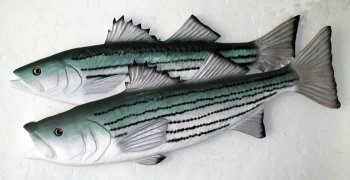Striped Bass on the Fly, Part 1
Striped bass, Morone saxatilis, are native to the Atlantic coastline of North America from the St. Lawrence River into the Gulf of Mexico to approximately Louisiana. They are anadromous fish that migrate between fresh and salt water, with spawning taking place in brackish or fresh water. The species is typically associated with estuaries and coastal waters.
They require high quality spawning and nursery habitat and abundant aquatic species for food. The estuaries of many Nova Scotia streams,
including some in Guysborough County, are rich in baitfish and home to adult striped bass.
Striped bass were introduced to the Pacific Coast of North America in the late 1800s and into many of the large reservoir impoundments across the United States for the purposes of recreational fishing and as a predator to control populations
of undesirable species. Striped bass have also been introduced into waters in Ecuador, Iran, Latvia, Mexico, Russia, South Africa, and Turkey primarily for sport fishing and aquaculture. The largest striped bass ever caught by angling was a 35.6 kg (78.5 lb) specimen taken in Atlantic City, New Jersey on September 21, 1982. The record-holder fought the fish from the beach for an hour and twenty-minutes before
landing it in the surf.
Stripers are dark olive green on the back with paler silvery sides and white on the belly. Six or 7 dark stripes run horizontally
down its sides. Striped bass are long lived fish, reaching up to 30 years of age. Although it has been recorded at lengths
up to 1.8 m, it rarely reaches 1 m in Canadian waters. The striped bass was once commercially important in Eastern Canada and is still highly prized by anglers
as a food fish.
Striped bass spawn in several rivers on the USA’s east coast and in two Canadian rivers, the Miramichi River (in the southern
Gulf of St. Lawrence) and Shubenacadie River (in the Bay of Fundy). A
particular feature of Canadian striped bass populations is that they may overwinter in rivers, presumably to escape cold ocean
waters. For the same reason, most east coast adult striped bass migrate southward, typically up to 1,000 miles, to overwinter
in warmer, richer waters.
In
his book, LL Bean Fly Fishing for Striped Bass Handbook, Lyons Press, New York, 1998, author Brad Burns suggests that learning
about our quarry will increase our angling success and enjoyment:
“The striper has an elongated body that is moderately compressed from side to side. This
characteristic means that the striper is not only a fairly fast swimmer, but also an agile one. By using its body height,
the fish can turn quickly in the water. A glance at the drawing of the striper also reveals its large, clearly developed fins.
Fins are like rudders in the water; having such large fins makes the striper highly maneuverable, hence its reputation for
being at home in turbulent environments. The tail of the striped bass is tall, nearly square, and thickly joined to the body,
eliminating the need for the supporting keels found on tuna, but sacrificing their streamlined design. This tail is designed
for short-burst power, not high- speed ocean swimming. The striper also has a clearly visible, highly developed lateral line.
This line possesses sensors that allow the bass to feel the vibrations of its prey, or the approach of predators. If you couple
the lateral line with the striper’s large and prominent eye, you have a night feeder, a fish at ease in low-light conditions.
The striper’s namesake is its six or seven stripes, which combine with a dark back and silvery sides used to break up
light. This camouflage design is made to hide the striper against the bottom, and to use sunlight to break up its image in
shallow water. Finally, the striper has a large mouth that gapes back to the eye and is filled with small, pointed teeth,
which also cover its tongue. These are not long teeth made to cut, they feel more like a rasp, and are designed to hold slippery
food so that it can be crushed and then swallowed. Under the skin of its body the striper has thickly muscled sides that are
largely made up of white muscle, as you might expect in a groundfish like a cod. But these muscles are also heavily interspersed
with dark reddish tissue, as you might find in a tuna or bluefish. These two types of muscle serve different purposes: The
white muscle provides quick energy for short bursts (again, you might expect this from a predatory groundfish like a cod or
haddock). The dark muscles, on the other hand, can retain oxygen for swimming sustained higher speeds, but once exhausted
they require a longer recovery time. Stripers need their dark muscles for surface feeding and for the extensive swimming required
by their 1,000 mile migrations.”
Next
week we’ll discuss fly fishing for this exciting sportfish.
Please stay on the line
…
